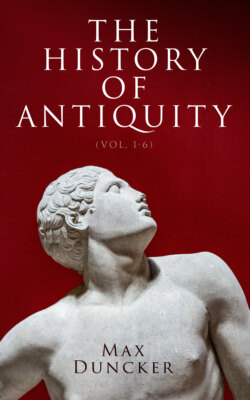Читать книгу The History of Antiquity (Vol. 1-6) - Duncker Max - Страница 19
На сайте Литреса книга снята с продажи.
FOOTNOTES:
Оглавление[234] Diod. 1, 45; Strabo, p. 816.
[235] Lepsius, "Briefe," s. 256; Mariette, "Revue Arch." 1860, 2, 21; cf. supra, p. 23, 56.
[236] Lepsius, loc. cit. s. 273, 274.
[237] Lepsius, "Briefe," s. 286; "Denkmale aus Ægypten und Nubien," 1, 2, 7, 82; Brugsch, "Hist. d'Egypte," p. 161.
[238] Rosell. "Monum. Stor." 1, 123, 136.
[239] Champollion, "Lettres," p. 263–283; Brugsch, "Hist. d'Egypte," pp. 163–165.
[240] Diod. 1, 47–49.
[241] Brugsch, "Hist. d'Egypte," p. 151.
[242] Lepsius, "Briefe," s. 112–115, 263, 403, 414.
[243] As this statue bears on the right shoulder the shield Ra Apepi, or Apepa, it has been thought to be the statue of the shepherd king Apepi (p. 130). Lepsius regards it as a statue of Ramses II.—"Königsbuch," s. 44.
[244] Brugsch, Hist. d'Egypte, pp. 197, 198.
[245] Strabo, p. 816, puts the number of the royal sepulchres at forty. Diodorus, on the authority of the sacred records, speaks of forty-seven graves. At the time of Ptolemy I. only seventeen were in existence (Diod. 1, 46), and of these, at the time when Diodorus travelled in Egypt, the greater part were destroyed. Lepsius gives twenty-five graves of kings, and fifteen graves of the wives of the kings ("Briefe," s. 270).
[246] Brugsch, "Reiseberichte," s. 324.
[247] Lepsius, "Briefe," s. 288.
[248] Brugsch, "Hist. d'Egypte," p. 128.
[249] Lepsius, "Briefe," s. 266; Rosellini, "Mon. Stor." 3, 2, 284.
[250] Bunsen, "Ægypten," 4, 213.
[251] On the sketch of this tomb on a Turin papyrus, cf. Lepsius, "Abh. der Berl. Akad." 1867.
